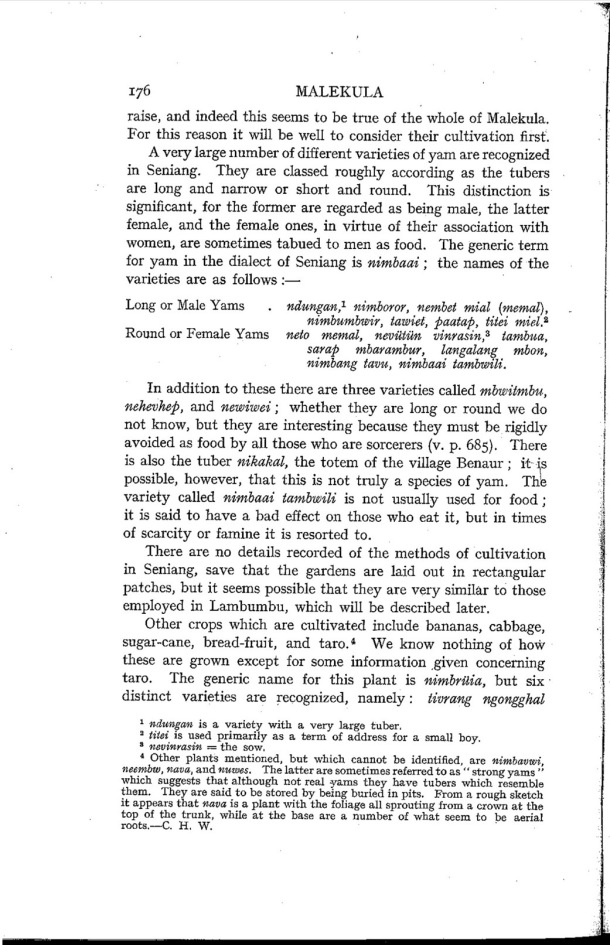|
|  [Note: this transcription was produced by an automatic OCR engine]
176 MALEKULA
raise, and indeed this seems to be true of the whole of Malekula.
For this reason it will be well to consider their cultivation ï¬Årst}
A very large number of different varieties of yam are recognized
in Seniang. They are classed roughly according as the tubers
are long and narrow or short and round. This distinction is
signiï¬Åcant, for the former are regarded as being male, the latter
female, and the female ones, in virtue of their association with
women, are sometimes tabued to men as food. The generic term
for yam in the dialect of Seniang is nimbaai ; the names of the
varieties are as follows :—
Long or Male Yams . ndungan} nimboror, nembzt mial (memal),
mlmbumbwir, tawiet, pump, titei miel?
Round or Female Yams new memal, nevamin irinrasinf tambua,
sarap mbarambur, langalang mbon,
nimbang tam, m'mb1zm' lamb-1m'li4
In addition to these there are three varieties called mbwitmlm,
mhevhejz, and newiwei ; whether they are long or round we do
not know, but they are interesting because they must be rigidly
avoided as food by all those who are sorcerers (v. p. 68 5). There
is also the tuber wikukal, the totem of the village Benaur ; it is
possible, however, that this is not truly a species of yam. The
variety called nimbaai tambwili is not usually used for food;
it is said to have a bad effect on those who eat it, but in times
of scarcity or famine it is resorted to.
There are no details recorded of the methods of cultivation
in Seniang, save that the gardens are laid out in rectangular
patches, but it seems possible that they are very similar to those
employed in Lambumbu, which will be described later‘
Other crops which are cultivated include bananas, cabbage,
sugar-cane, bread-fruit, and taro.‘ We know nothing of how
these are grown except for some information ‘given concerning
taro. The generic name for this plant is nimbruia, but six
distinct varieties are recognized, namely : tivromg ngongghul
‘ mirmgam is a variety with e. very large tuber‘
1 titsi IS used primarily as a. term of address for 9. small boy.
' nevimasin =the sow.
‘ Other plants mentioned, but which cannot be identiï¬Åed, are nimbavu/i,
neembw, mwz, and Ymwas. The Latter are sometimes referredto as “ strong yams â€ù
which suggests that although not real yams they have tubers which resemble
them. They are said to be stored by being buried in pits. From a rough sketch
it appears that naua is a plant with the foliage all sprouting from a crown at the
top oi the trunk, while at the base are a number of what seem to be aerial
1'0Of8.—C. H. W.
V
.,=<‘
.i*‘l
|